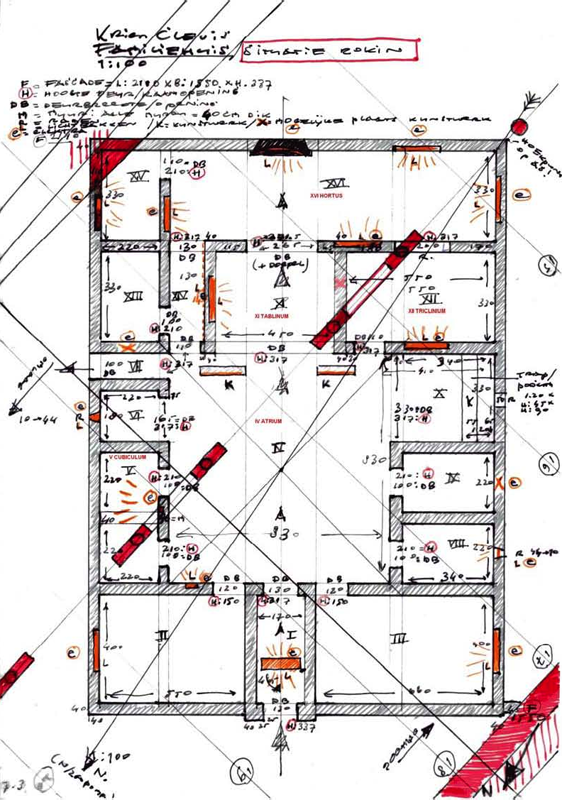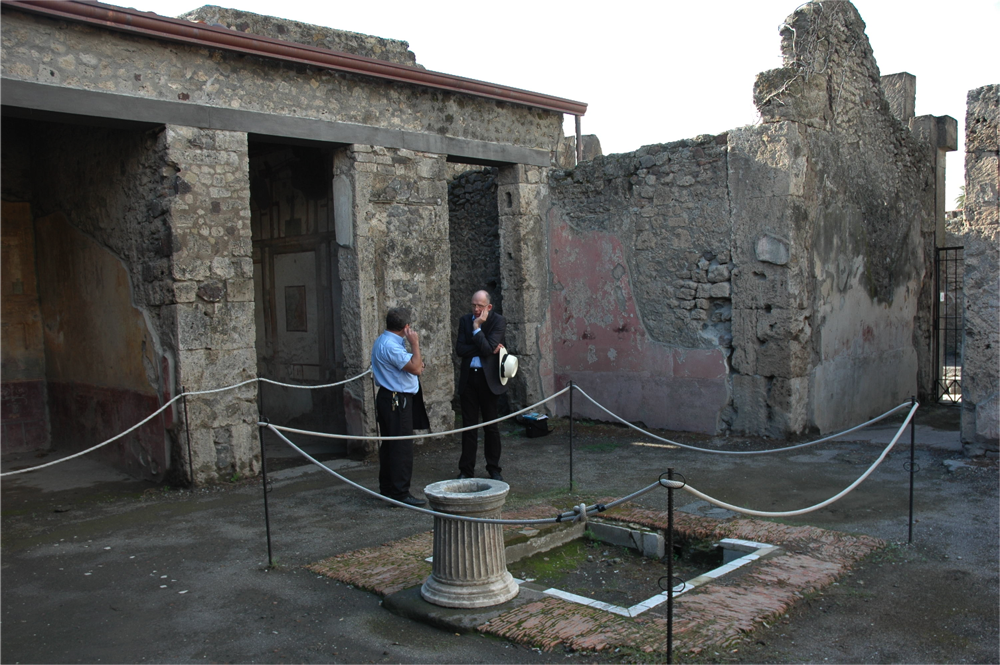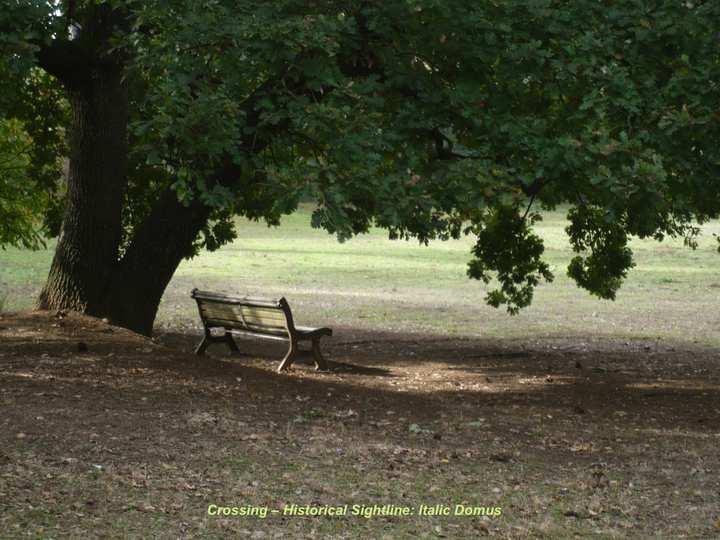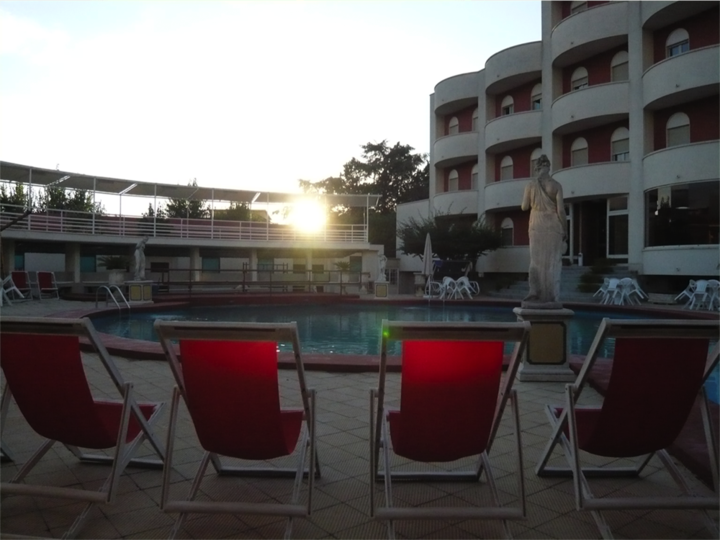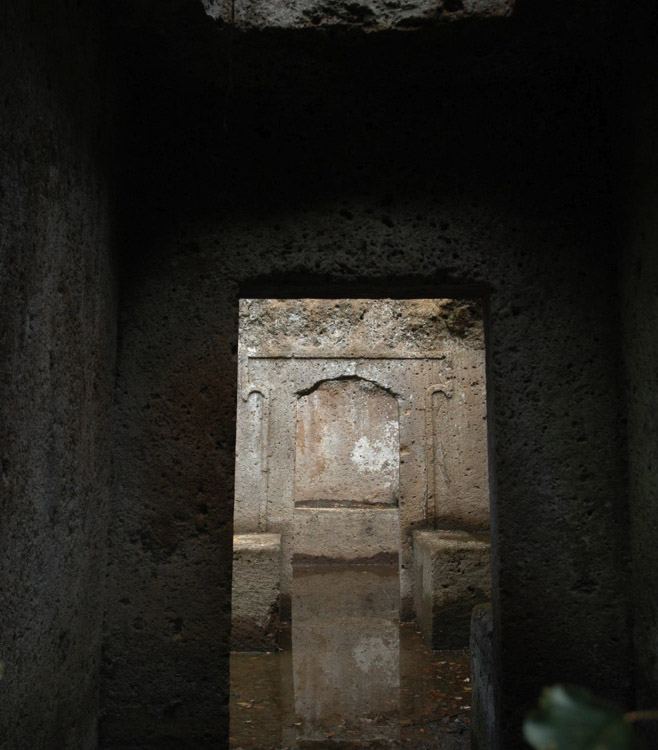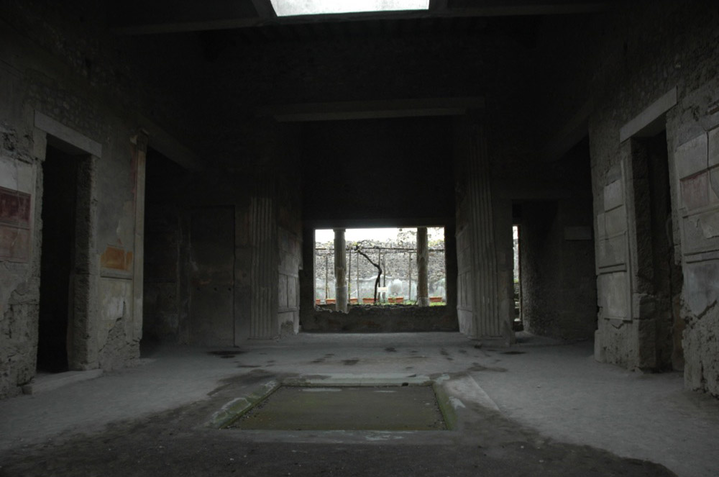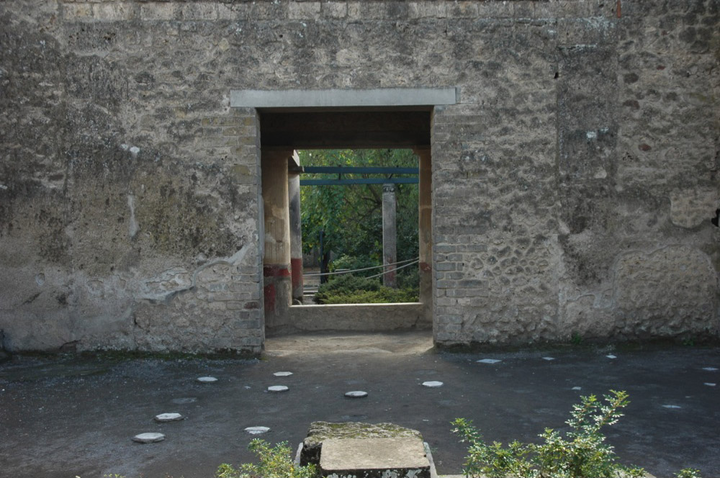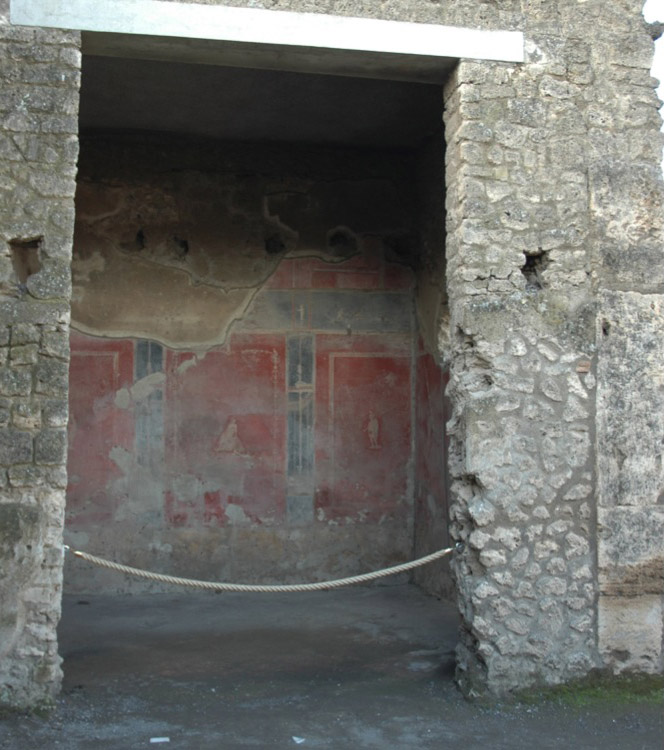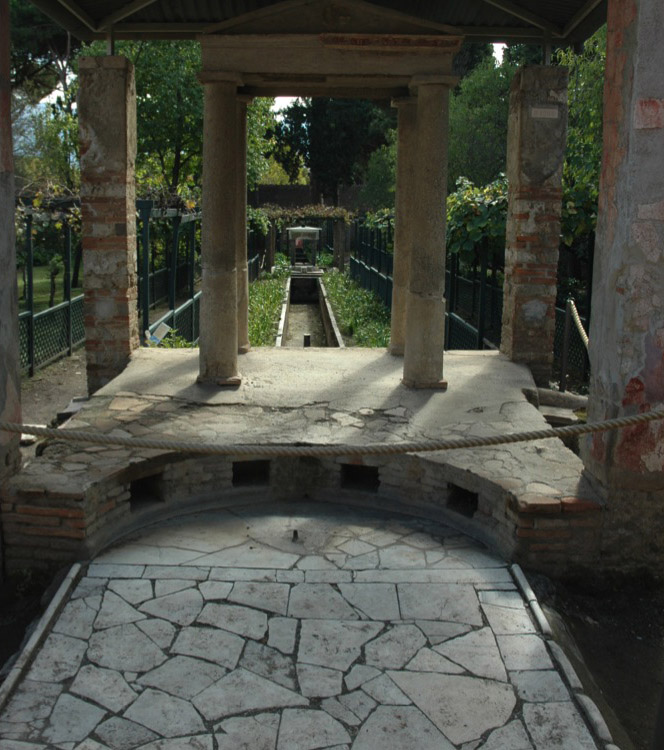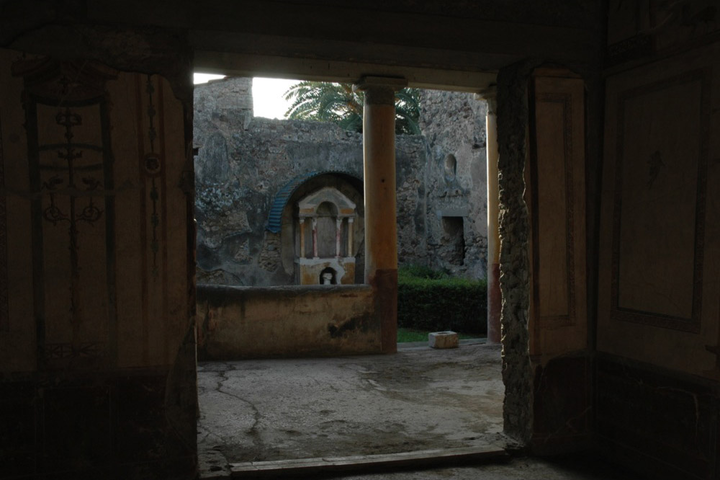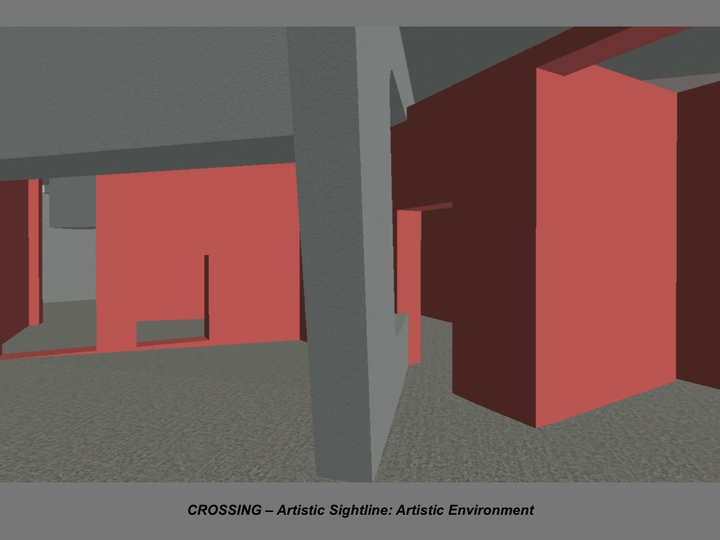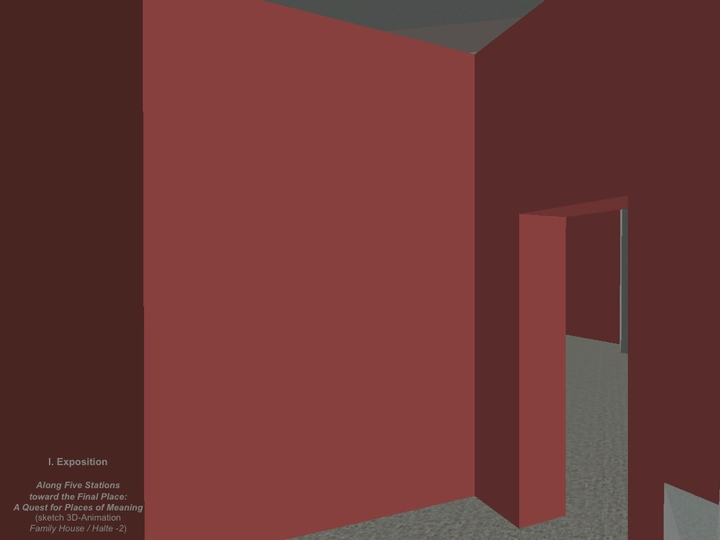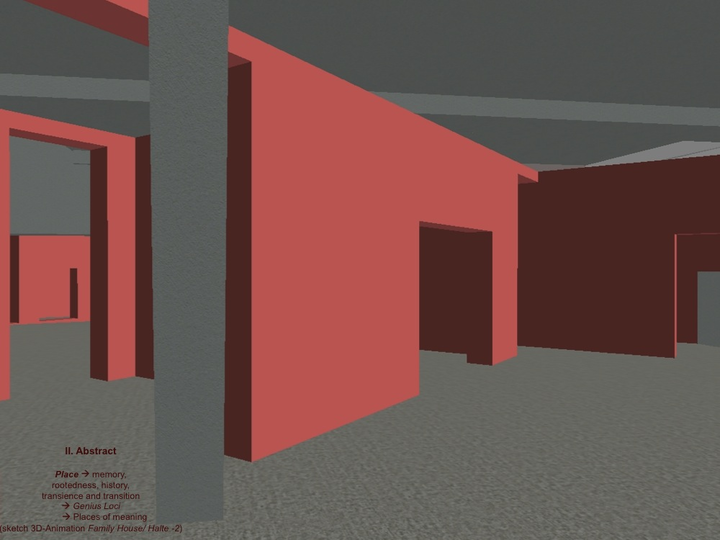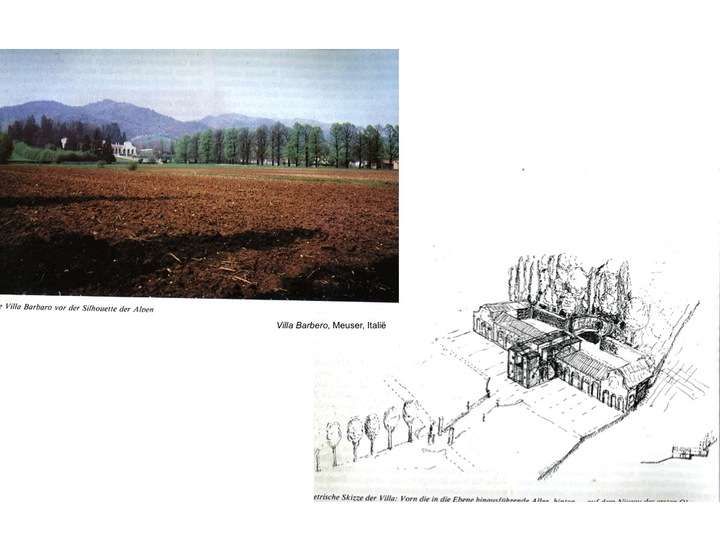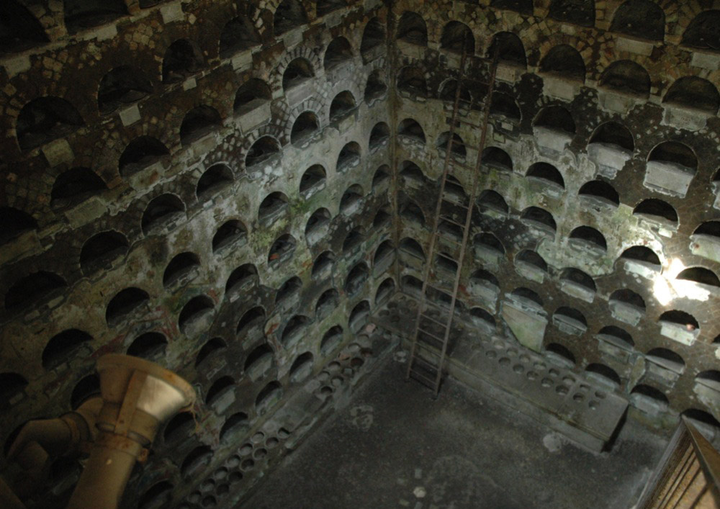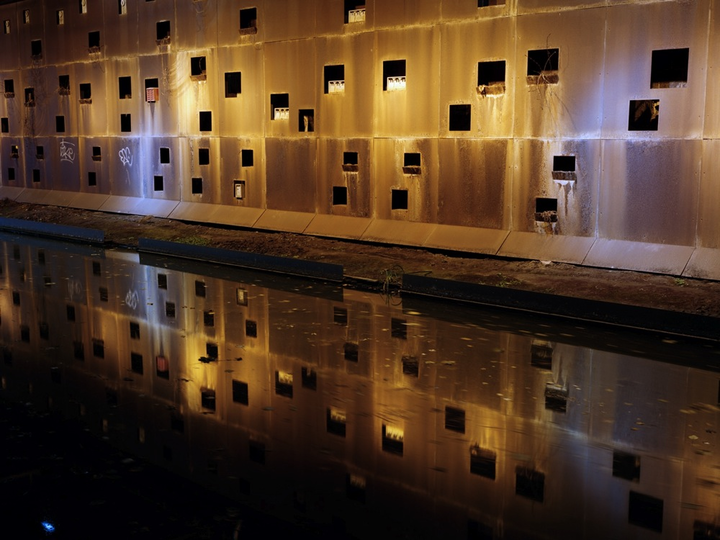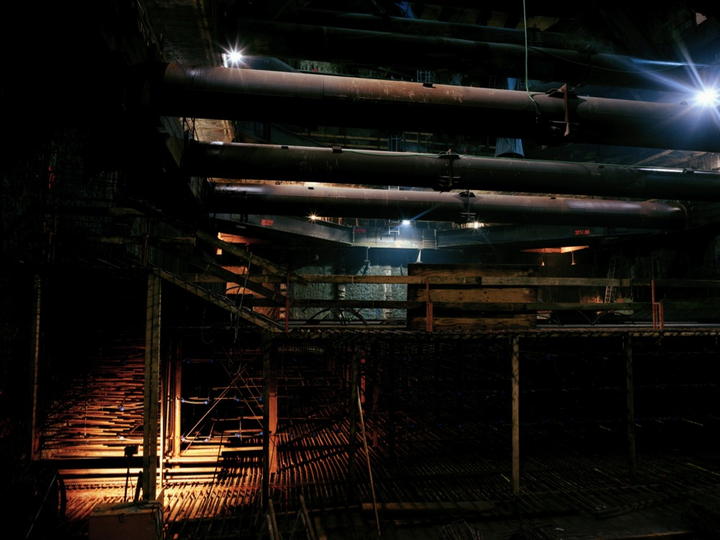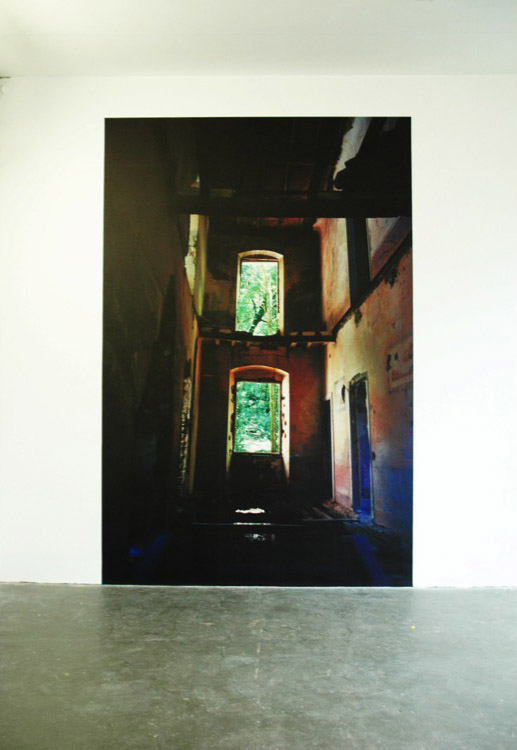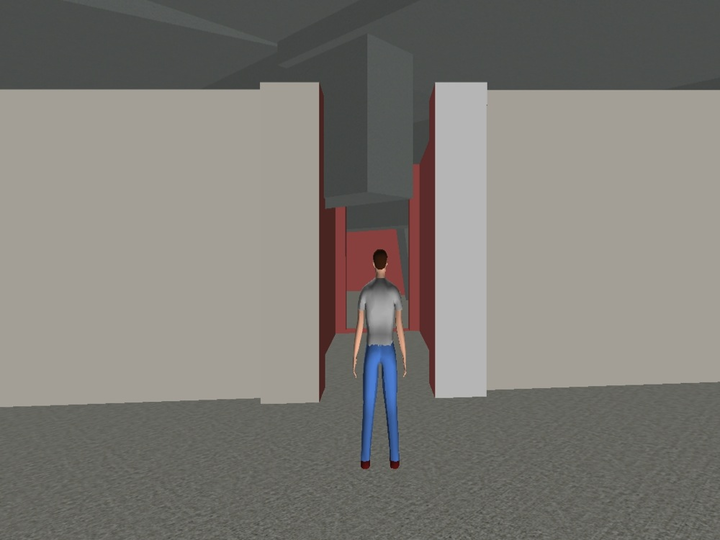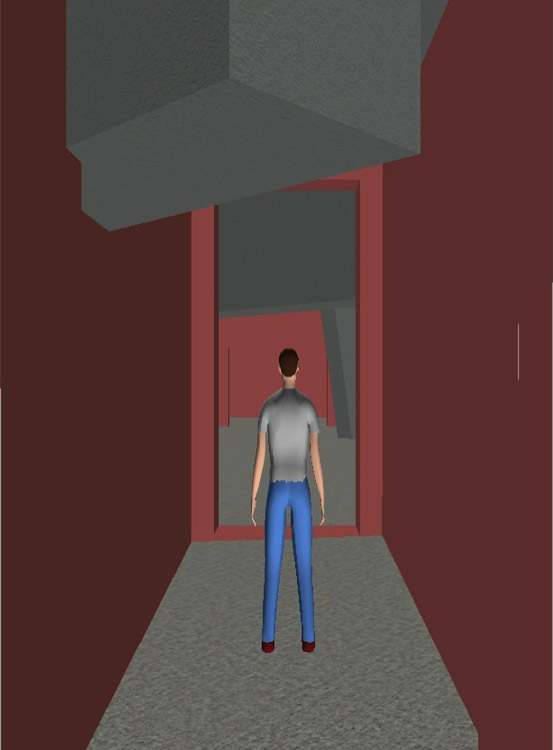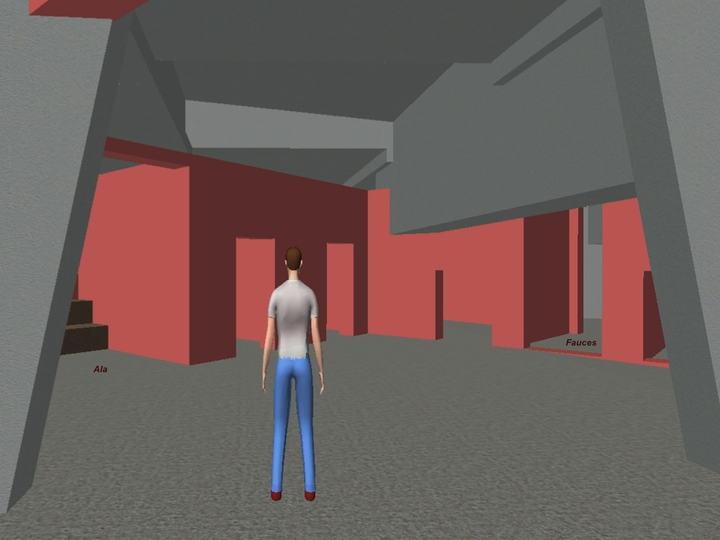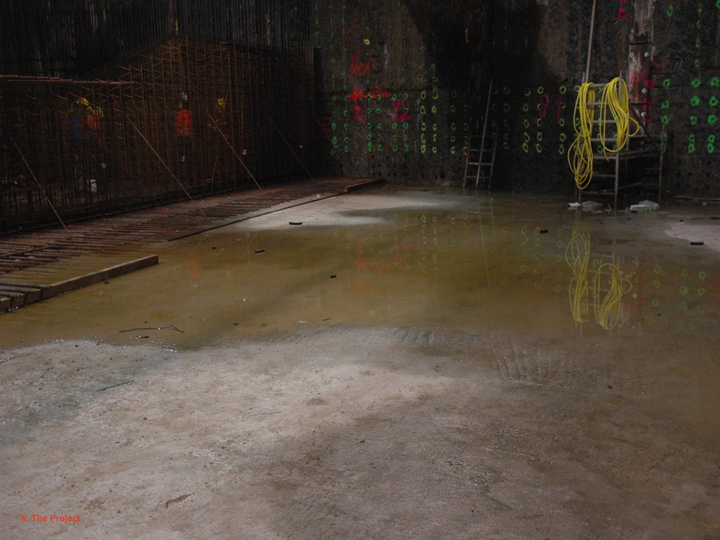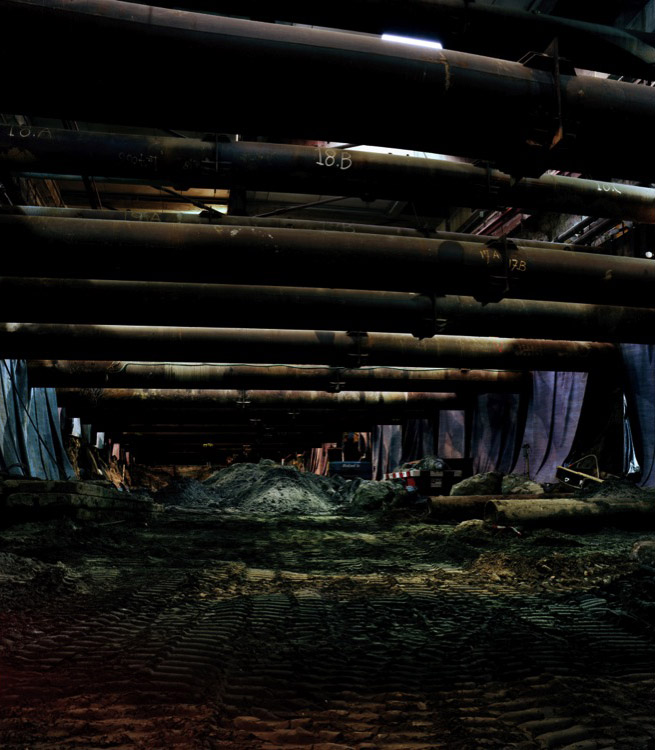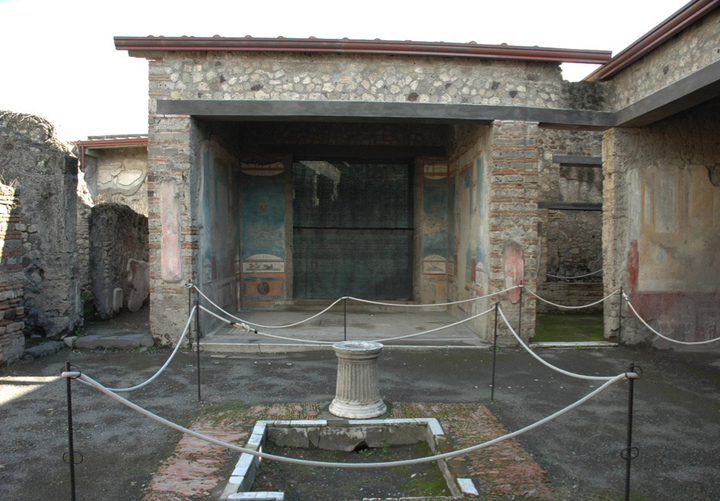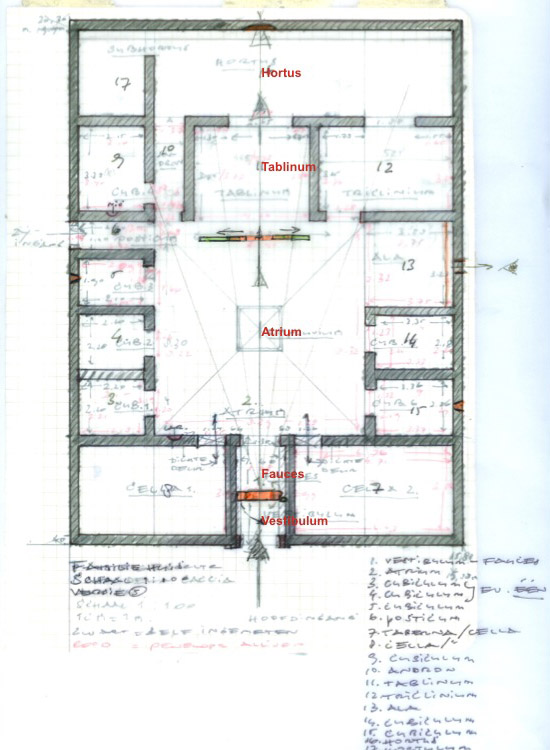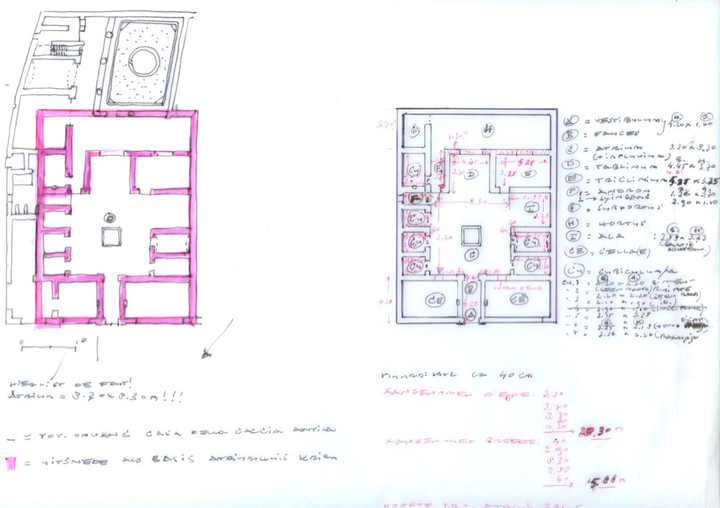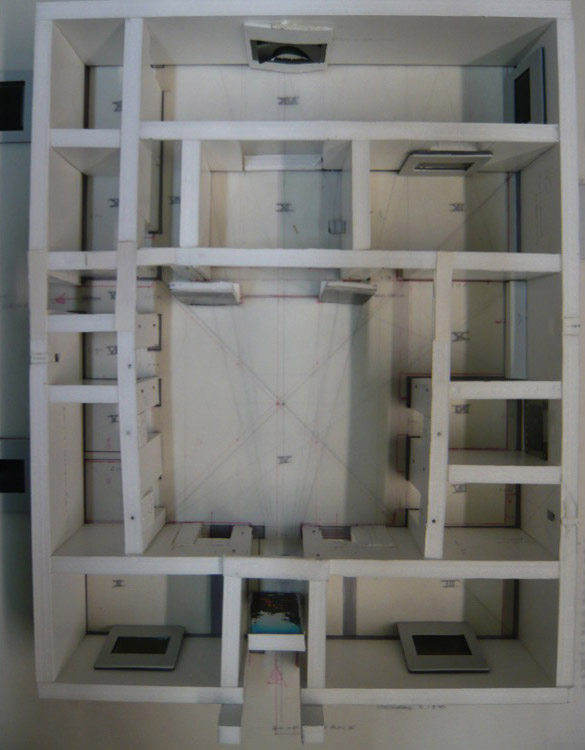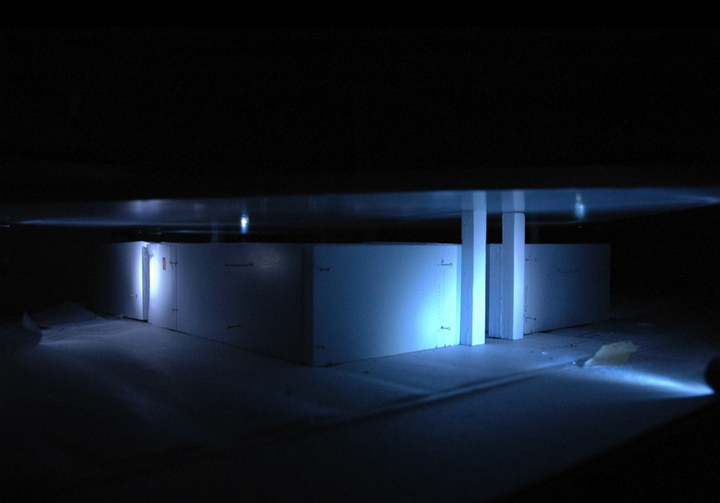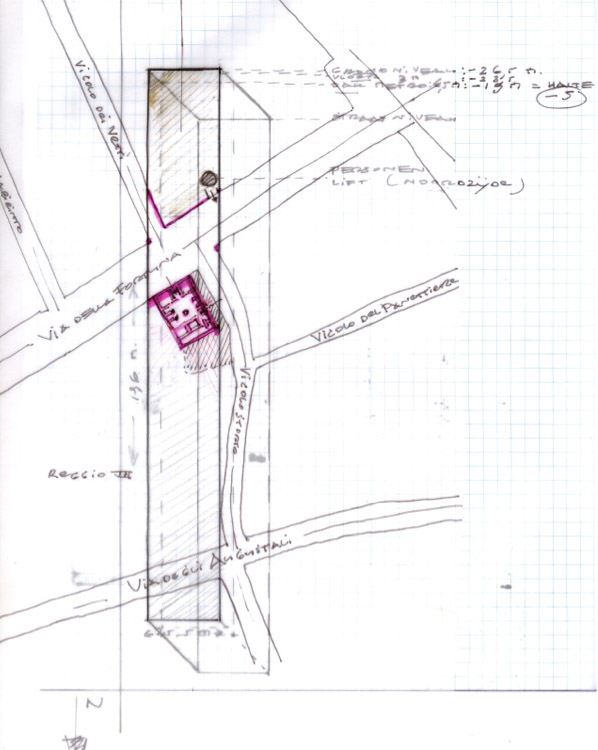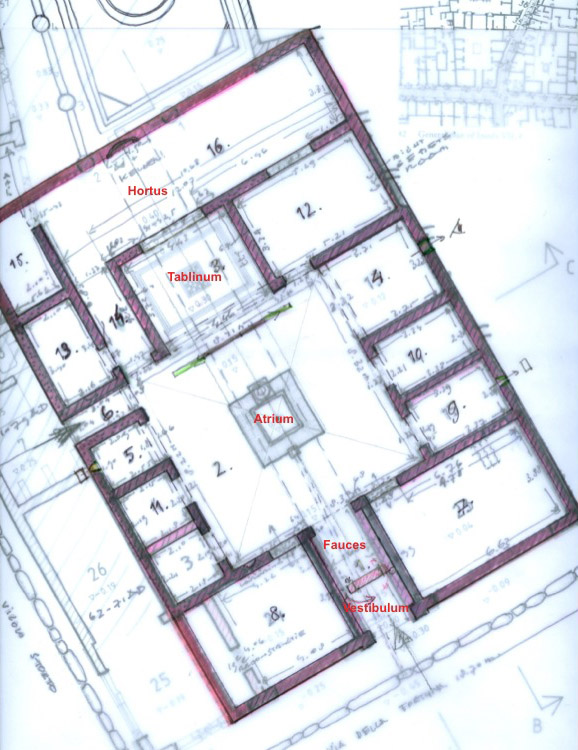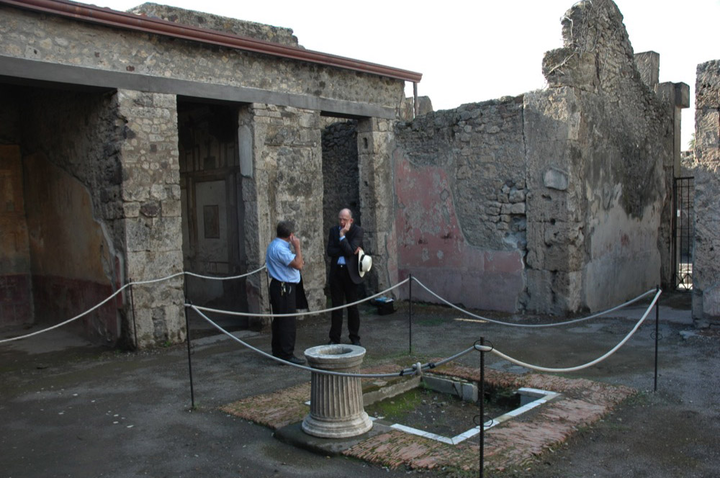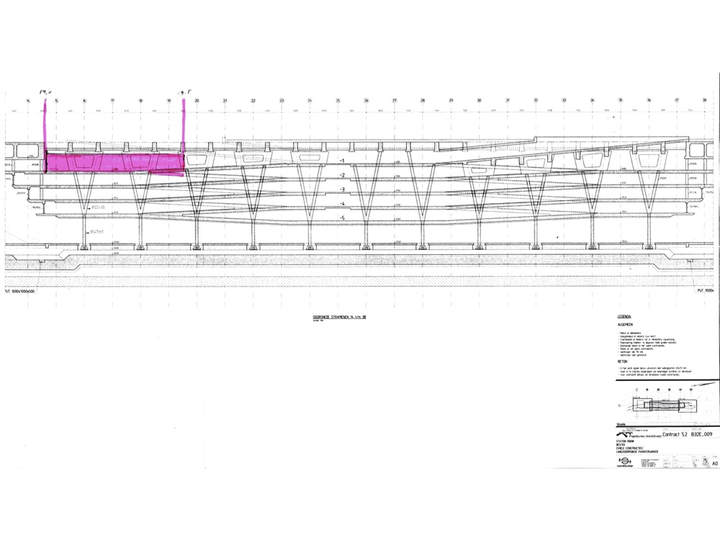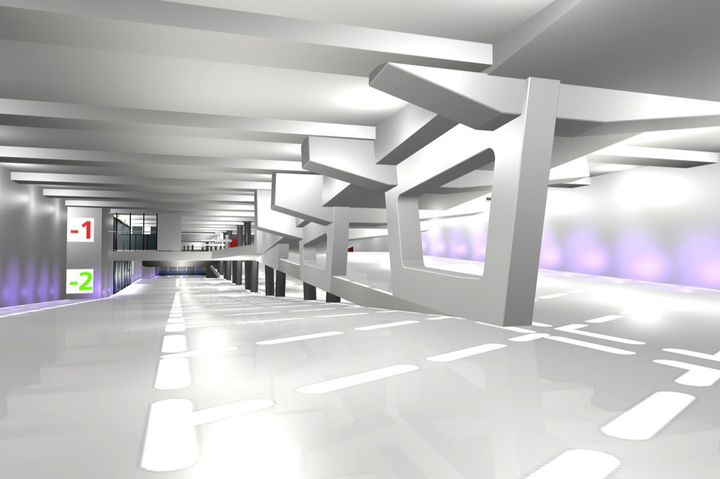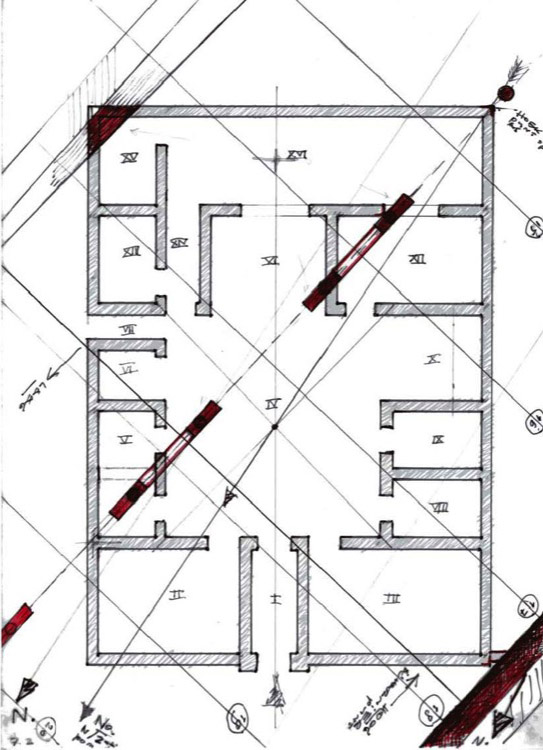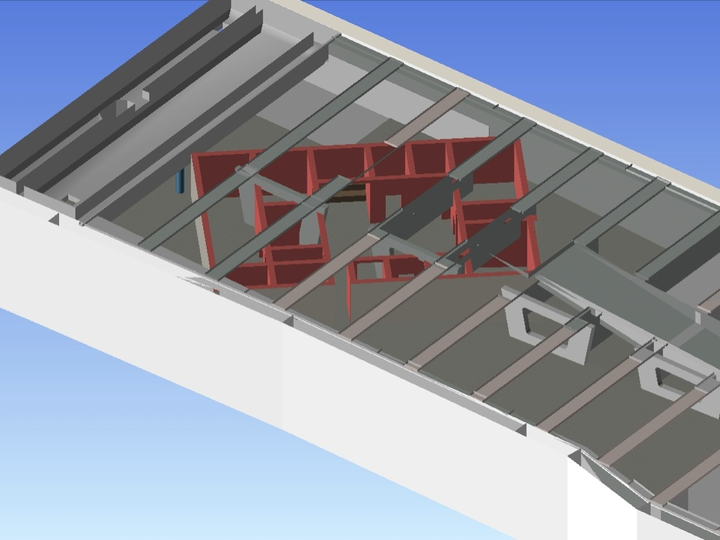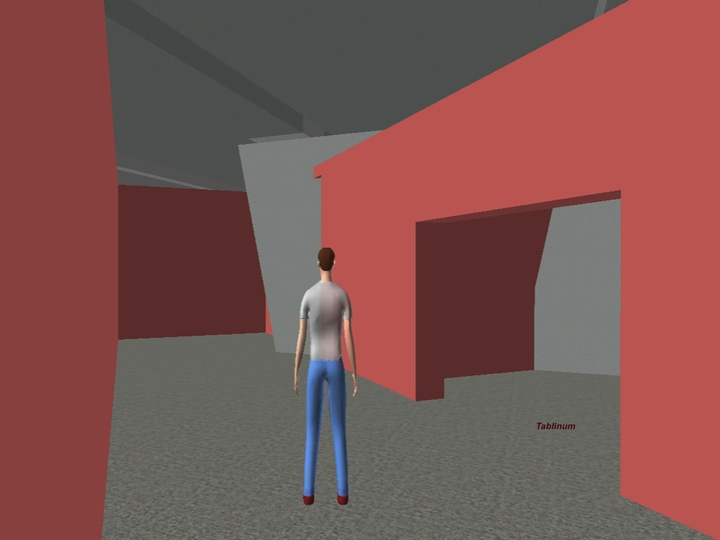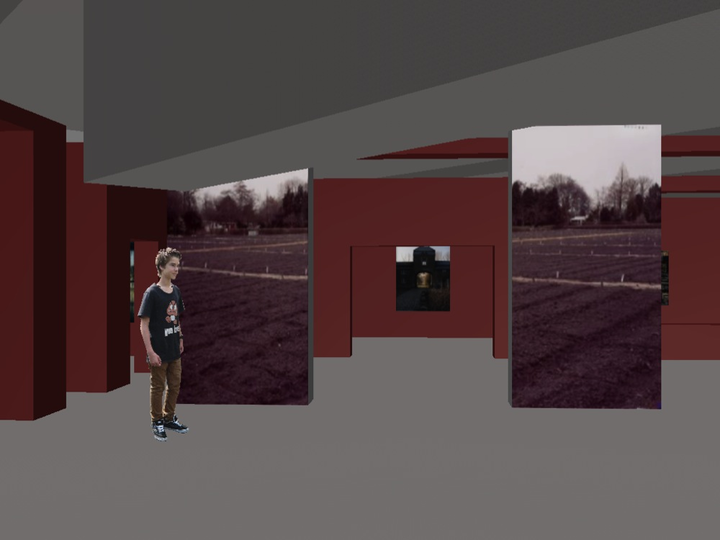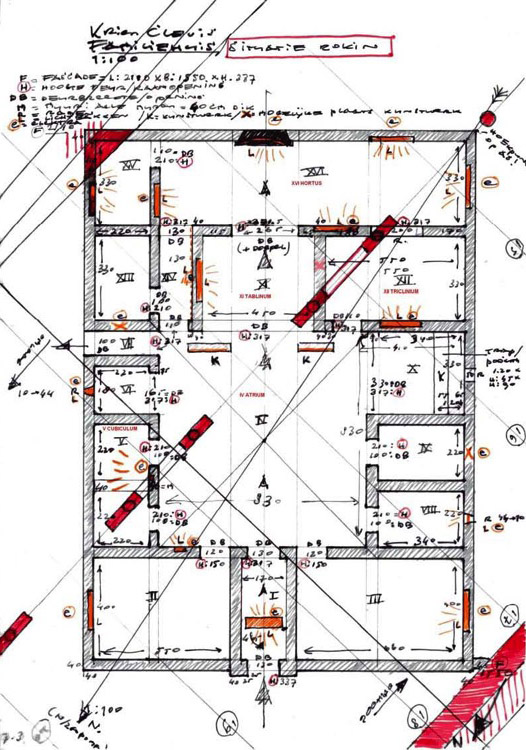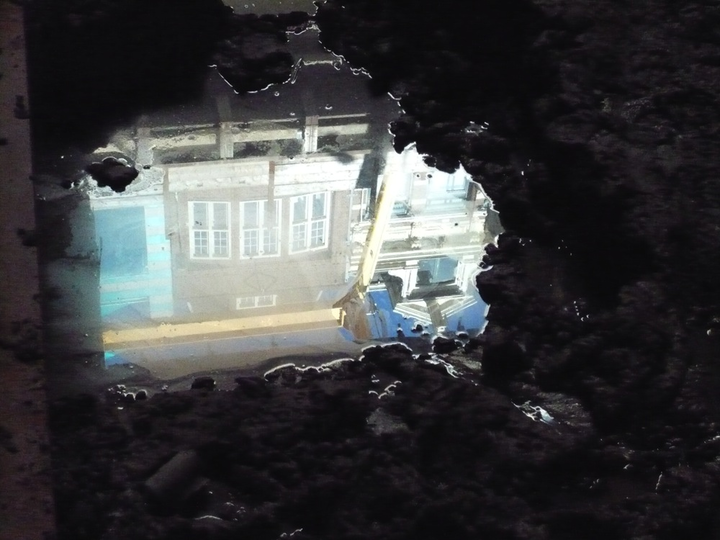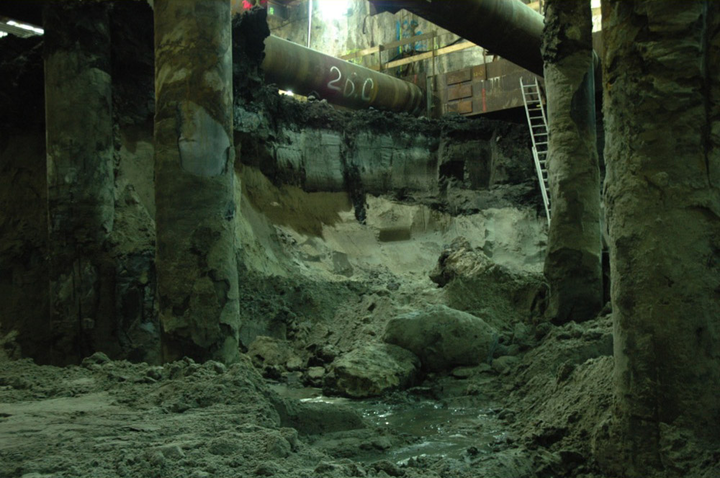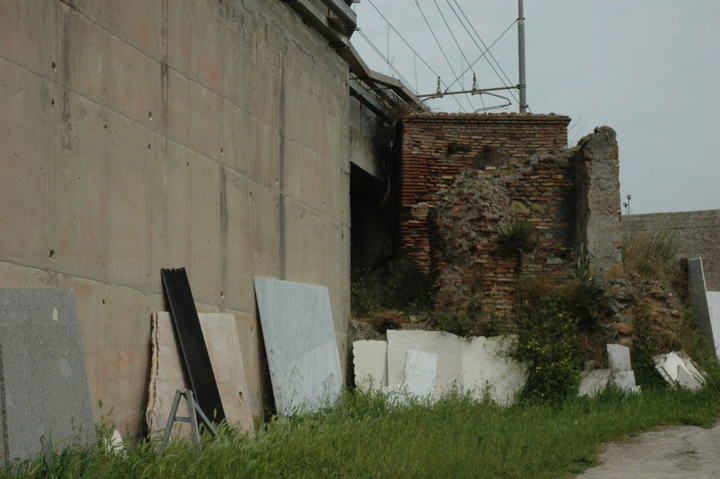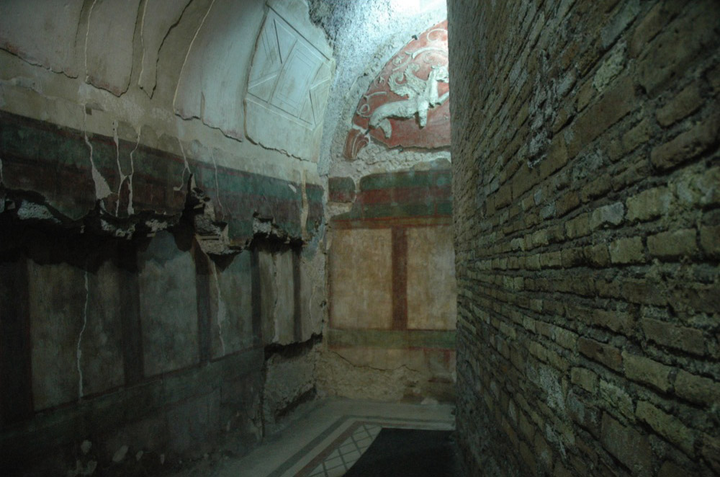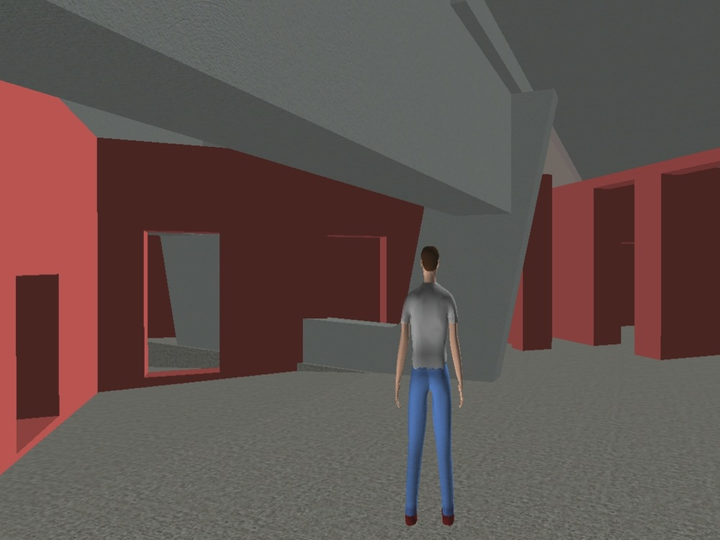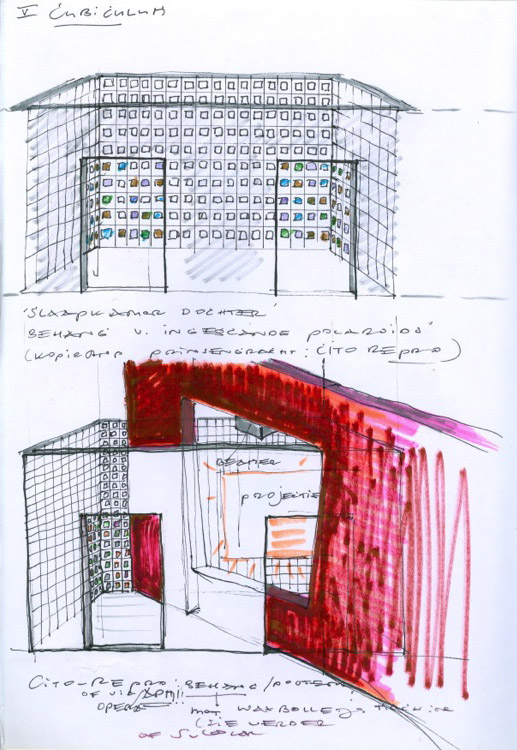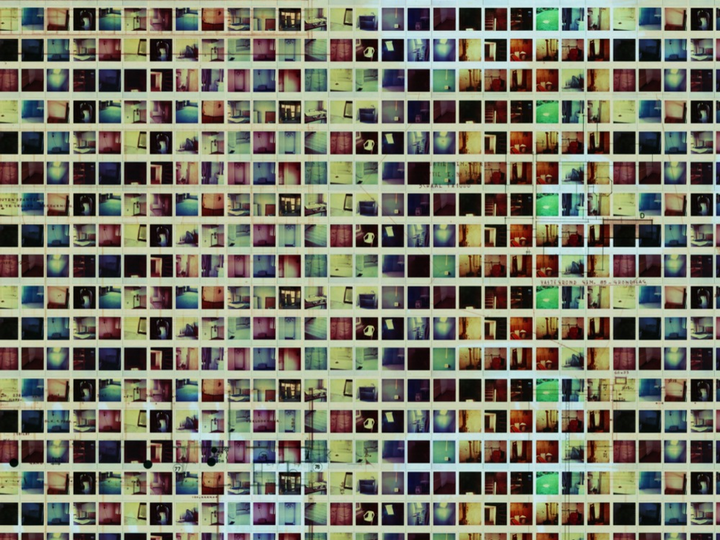Where the archeologist in me stops and the artist in me takes off
Since Pompeii I know: when you roll out your tape measure, the house is yours. By establishing the measures of a house, you make it your own. The door openings, the reconstructed heights, the windows, the now hidden evidence of where all sorts of things were in the house – traces of earlier archeological study invite further investigation. But at this point the artist in me awakens: I want to see it, make it, translate it according to my own standards. Even before having studied Penelope Allison's book on the subject, I had outlined my scale-model already, resulting from my own measurements. After half a year I called in an expert, and now I know that I could not have done otherwise in order to arrive at a proper interpretation of the Casa della Caccia Antica. Although this interpretation is now based on my own observations and measurements, it would have been different if initially I had had more knowledge available. This not-knowing I experience as valuable if not crucial – as artistic freedom in my design process, as a blankness that allows me to explore and develop my own options and visions. Most fortunately, though, after consulting the work of Allison my observations of the house proved correct, a few details excepted. But I also made a mistake: the door openings closed off with mortar and later rediscovered (from atrium to cellae and vice versa) were closer to the vestibulum/fauces. This means I have to render this entrance space slightly smaller. Yet this will only improve my design, in fact, also because it reveals more strongly the correspondence with the entrance areas of the Etruscan tumuli. What is at least as interesting, in my view, is my decision to put small windows on the west side of the house. Now I know that Roman law allowed placing windows that look out onto undeveloped land. There were in fact small windows on the west side, which were later sealed off with mortar when the adjacent property was built. Likewise, the slave quarters, which initially I removed intuitively, were actually built later, to fill up the undeveloped land on the eastern street side. How wonderful to be able to rely on your intuitive notions and to be able to believe what your eyes can see! (Note in the margin, 31 May 2011)
Between 2009 and 2012 I made several visits to Italy to study at the Royal Dutch Institute in Rome, as well as to carry out historical field research in Pompeii, Herculaneum, Rome and Cerveteri. These trips were designed to provide material for writing several essays and developing an installation based on the classical atrium house.The various differences and interconnections between these two ancient sites of life and death as two extremes have been essential to my research. In this exposition I report on my artistic research.
Hotel Villa dei Misteri is located on a backstreet, a stone’s throw away from the excavation site’s exit near the famous Villa dei Misteri in Pompeii. My hotel seems like the only paradisiacal residence in the rather indefinable surroundings; the neighborhood, apparently, is far from safe. The hotel was built around a swimming pool, and it vaguely reminds one of an expensive resort, albeit one that has not reached full glory yet. Built in the 1960s, its cement-colored look suggests it was never finished, even though the concrete was painted in the 1990s. At the same time, today’s visitors will readily accept its look as authentic: after all, antique statues we also like better uncolored; faded white marble has become an integral part of our cherished image of classical antiquity.
The round swimming pool is the vibrant geographical and social heart of the hotel complex. Because of its architectural layout, the pool serves as an intersection, where all the various daily activities of staff and guests – such as fun, work, eating, lounging and living – converge. Moreover, the guests who sleep in rooms across from the main hotel building have to pass the swimming pool, while staff and guests alike make use of the elevated footbridge across the pool to go to the hotel’s restaurant. Most guests stay in the upper section of the main building, while the staff and the owner’s family reside in rooms on the side. As such, the pool sits on the central axis of the crossing generated in this location, mediating between its public and private spaces, between architectural design and actual social use.
The hotel is located on the edge of modern-day Pompeii, which like a ribbon development gradually emerged along the excavation’s site, parallel to one of its major arterial roads, the Via Porta Nocera. The central district consists of a square with a pompous early-twentieth-century church: the Santuario della Beate Vergine del Rosario. At one point in the nineteenth century, as the story has it, a painting depicting the Madonna was carried in a procession to Pompeii. Once the procession reached town, the Madonna began to cry. This was enough reason for erecting a huge church, to accommodate the flow of pilgrims that would flock to the location from that time onward. The town, which used to be poor, profited greatly. It is rumored that the extra income served as compensation for the minimal benefits from the nearby ruins.
Over the years, Via Roma would evolve into the main shopping promenade of Pompeii. Shops that sell religious bric-a-brac and luxury fashion stores (from Sissi to Intimissimi) are found side by side, and there is also a McDonald’s. On a Sunday afternoon after the Vespers, loads of pilgrims stroll along the Corso and back to their bus. The gelateria is filled with noisy children and chatting mothers, while the men will seek refuge in one of the many tiny bars. Along the fence, with a view of the Necropoli of the Porta Norcera, one is likely to spot young couples kissing. All things seem to come together in Pompeii: past and present; religion and commerce; life, love and death. The ways in which people experience Pompeii will vary during the day. Like in any busy town, the hustle and bustle of life takes shape as on ongoing social crossing of all sorts of people hurrying into all directions at different times of the day.
In contrast, the Pompeii of antiquity represents a silent and lasting memory, irrevocably solidified in lava, having turned into one giant cemetery in a matter of minutes after the volcano’s eruption in 79 AD. Nowhere else did life and death meet each other so intimately as here. This is not only reflected in the dead bodies cast in plaster, but in particular in the sites where life still seemed to be going on and that were recovered from under a thick layer of ashes. At Pompeii, the huge excavation site, one can study solidified life, as a snapshot of the apocalypse. Life in Pompeii was reflected in its houses, where people lived and performed their daily rituals at fixed times in public spaces or private quarters, together with family, friends or clients, or alone. In some ways, ancient Pompeii is a living city of the dead. In the middle of life, death suddenly forced itself upon the residents, but also in life Pompeii was closely linked up with death.
The floor plan of its characteristic house, the Italic domus, shows a strong resemblance with that of older Etruscan graves. This so-called classical atrium house is rooted in Etruscan-Italic culture and is mirrored in Etruscan burial culture; it has specific names for the various spaces such as atrium, tablinum and triclinium. In fact I also encountered these names, such as cubiculum, in Roman pagan and early-Christian burial culture, and they were synonymous with a specific use of the spaces. If these spaces in Roman burial culture reflected the certainty of eternity, their use in the design of Pompeian homes seemed much more fleeting and complex.
II
Crossing: Combined Public and Private Domain
Domestic life in ancient Pompeii seems radically different from that in modern Pompeii. One of the most striking differences is the relationship between work and private life. Today people will walk in the park or parade along the Corso on a Sunday, after which the next day everyone will go to work or have business meetings away from home. The separation between work and private life is clearly a modern phenomenon. In ancient times, however, work and domestic life used to be much more conflated. In the Italic domus, the urban home of antiquity, domestic life and work were not sharply delineated; work was performed outside of one’s home, in the public domain, only in very specific situations. Moreover, the role and function of particular domestic spaces were also dependent on the time of day and the people who were present. Living in a house involved an intricate network of social ties among residents – family, staff, slaves – and visitors or guests. There was a delicate interplay between visiting and receiving guests. The reputation of the master of the house, the Dominus, who saw his dwelling as an expression of his social aspirations, thereby played a crucial role.
Although several classical archeologists assume that in the Pompeian house there was a strong separation between public and private rooms, this separation was less strict in practice. Official receptions centered on the Dominus, and were held not only in the tablinum, which was designed for such gatherings, but also in the private quarters that were temporarily used for hosting guests – as social space. Furthermore, the degree to which a house was open to outsiders played at multiple levels. Depending on the visitor’s standing and the time of day, more or fewer rooms were used for this ceremonial role.
In ancient Pompeian homes, then, one could regularly observe cross-fertilization between public and private spaces. The Italic domus of that era actually suggests a jumble of persons and things. At different times of the day, the domus accommodated activities associated with work, eating, sleeping, leisure and public life. It offered space to live not only to the master’s nuclear family – including his parents and unmarried sons or daughters – but also to slaves and their family, released slaves and private teachers. All were part of a hierarchy that already applied when entering the house. The main entrance was used solely by those who belonged to the immediate family of the Dominus, while the side entrance was for slaves and other staff. Thus the dependency relationship among residents was reinforced in the design of the house. Inside the house, however, it becomes harder to distinguish between public and private use of spaces. Friends and dependants, businessmen and relatives, humble clients and worthy notables – all came together in the same space. How were both the expectations of visitors and the private needs of residents reflected in the design of the house? How did the various categories of people share life in the domus, and to what extent was its architectural design legible to the visitor and livable to the user?
To understand the versatile use of the Italic domus, it is crucial to consider the daily timetable with regard to visitors, receptions and forms of social interaction. For example, in homes of distinguished people, the so-called salutatio, the greeting of the master of the house by visitors, guests and clients was an important ritual. This ceremony only took place during morning hours. Guests entered through the main entry, the vestibulum and fauces; they met each other in the atrium and politely awaited their turn in the alae, spaces leftward or rightward in the back of the atrium, until they were received in the tablinum, where the salutatio took place. In architectural terms, the vestibulum was directly connected with the tablinum via the atrium, situated along a symmetric axis, and the sideward alae. Symmetry and sequence of spaces in the Italic domus, then, was entirely at the service of the main social ritual involving the host and his guests, the salutatio, which also revealed the social standing of both parties. This ceremony subsequently took place in the main room of the house, the tablinum or family room, which was adorned with wall decorations and fancy furniture, and where the tabulae, the family archives, were stored and displayed. In this room, the host and his guests shared and passed on important information. As such, this space functioned as a vital interface between public and private life in antiquity.
III
From Crossing to Framed View: Identity and Context
The notion of representation plays a major role in the development of the atrium house. In this respect the violence of nature has made visible a specific layer of time in Pompeii. After extensive visits to the excavation site, I understand we should always look at life in ancient Pompeii from a specific temporal angle. This life is visible in the classical atrium houses, from between about 450 BC and 79 AD, as a solidified stratum of time.
In the context of my project I would like to highlight the development of the classical atrium house and its changing uses. Its architectural hierarchy of spaces is closely connected to their representational function. As indicated, the latter was reflected in the salutatio. Apart from the existing architectural hierarchy in the atrium house, the salutatio added a social hierarchy in the corridor, leading from fauces via atrium to tablinum. Both the architectural design and the actual usage of the domus defined and reinforced the level of importance of its spaces.
Casa di Octavius Quartio, Pompeii. Former tablinum as andron to the new peristylium (study photo: Krien Clevis)
However, the salutatio did not always exist as a common ritual in Pompeii. With the expansion of the atrium house with a patio, garden and garden rooms – by adding, in other words, a second atrium to the house and making it ‘deeper’ – the representational function of the former atrium and tablinum diminished. At one point the tablinum even disappeared altogether, or was remodeled into a passageway leading to a second atrium: the so-called peristylium or arcade.
Likewise, the alae were no longer needed as waiting spaces for the tablinum. They were turned into cubicula. Although these rooms were formally part of the entrance complex of the domus, their meaning changed over time. This underscores that the prevailing mode of salutatio was going out of fashion, which also changed its form and location. The formal reception in the classic atrium house seemed to turn into a more informal one, in which it was rather important to present the new taste of home design to acquaintances and guests with social status.
The representational function of the house shifted to the inner courtyard, or hortus. Still, even though this hortus and peristylium come across as more frivolous and less formal designs, thus attributing another role to the guests, one continued to play with and exploit each other’s mutual social standing. So even though the ceremonial receptions changed character, there was still a ceremony. And even though it seemed as if now the guests were given aces to the domus’ private space, this space temporarily took on a public role, causing the newly accessible spaces to acquire a public status. In other words, the relationship between public and private shifted. This involved a continuously changing process and the separation between the two domains in fact became increasingly more diffuse and complex and is only present as a temporal dimension.
This transformation was accompanied by a more personal rendering of the layout of the house by the Dominus. Gradually the master of the house developed a more individual desire and taste to design his house as optimally as possible for both guests and his own use. For example, the so-called framed view was introduced: at first through the opening or (dis)placement of the columns in the peristylium, to allow for the best view from the indoor space; and secondly, by putting emphasis on what was important to be seen.
For example, the triclinium came with a vista of a stream in the hortus, the inner courtyard, and the visual lines and silhouette were emphasized by adding small fountains and statuettes on or near them. But also the application of elements of domestic religious devotion, such as the Lararia, small house altars for ancestral figurines, should be understood in this context.
Lararium of the Casa del Principe di Napoli from the hortus, seen from the summer triclinium, Pompeii (study photo: Krien Clevis)
More than personal taste, however, the framed view of a house and garden expressed individual identity. Taste, after all, was subject to a collective fashion. Taste is intersubjective. A house did not just mirror individual taste; in particular it represented communal and social habits and customs. Taste, as a collective idea, always implies a context. When this context changes, because of changing social rituals, this also influences architectural developments. At the same time, the new taste of home design represented distinction and status. Having taste makes you belong to a larger whole. Taste is to be regarded, then, from the perspective of inclusion: wanting to be included in a changing yet hierarchical society. The experience of the framed view and the positioning of Lararia are reflective of the taste of the master of the house; and therefore these had to be shown and shared with the visitors whom he gave access to his house.
It is important for me to know that the framed view of atrium houses went hand in hand with their user function, represented in the salutatio ritual. The one was at the service of the other, mutually reinforcing each other. It is also interesting for me to know that this also represented a particular portrait of an era in which the salutatio was common. After all, the spaces designed for it around the atrium, such as the tablinum and the alae, vanished to make room for new representational practices in the garden. The hortus and the peristylium thereby suggested a more informal character than the former atrium, and this paved the way for receptions and parties in designated, flexible places. This gave rise, in other words, to multifunctional party spaces and dining rooms, oeci and summer triclinia. An important factor thereby was the principle of framed view, and the vista’s created specifically by reasoning from the experience of user. The latter appeals to me because the user could apply ever more liberties with regard to the design of his house, thus gradually developing an identity of his own. When the salutatio and the interrelated architectural rules disappeared to make room for individual experience, which in turn gave rise to individually created framed views, the identity of user and place became visible.
More or less separation of public and private domains is inherent to the social context. Similarly, crossing is determined by developments in this context. It is an essential part of the identity of the user and his place. Social function and individual design, ritual and use go hand in hand in the classic atrium house. At the intersection of public interests and private needs, there is room for individual identity, which is anchored in the geographical and social standing of its residents.
Crossing. Living in Rome, dying in Pompeii
Final evening as promised: Canova on the Piazza del Popolo. Enjoying the square and its busy traffic one more time: quarreling taxi drivers, stylish ladies with dressed up dogs, grumbling tourists, parading schoolgirls, men talking into their cell phones… Human crossing from all directions on the Piazza del Popolo, the large atrium behind the similarly named gate, the vestibulum of Rome, at the end of the Via Flaminia. All sorts and sizes, a color palette of people, from ramblers to hotel guests – all are passers-by on a lively square. As social and geographical heart, the square encloses you after you passed through the gate. Once inside you need to find your own way, choose your own direction. Welcome to Rome! (Note in the margin, 22-10-10)
References
Penelope M. Allison, The Casa della Caccia Antica, Band 11/VII 4, 48, (Munich: Hirmer Verlag, 2002)
Jens-Arne Dickmann, Domus Frequentata. Anspruchsvolles Wohnen in pompejanischen Stadthaus (Munich: Verlag Dr. Friedrich Pfeil, 1999)
Kees Peterse, Steinfachwerk in Pompeji. Bautechnik und Architektur (Amsterdam: J.C. Gieben, 1999)
Andrew Wallace-Hadrill, Houses and Society in Pompeii and Herculaneum (Princeton, New Jersey: Princeton University Press, 1994)
As of 2009, I have been working towards a PhD at the Academy of Arts of Leiden University. So far I have devoted my effort to focusing my research and developing my topic. Put simply, my PhD project investigates the meaning and quality of place in my artistic work, while I also explore how this notion relates to memory and transition. This research has three major dimensions: my artistic work, an empirical element and a reflective component.
II
Abstract
In my visual artwork place is tied to memory, rootedness, history, transience and transition – notions that in my project all converge in concerns closely associated with death. To understand these concepts and the places involved, I investigate the physical and qualitative aspects of specific places, in particular places with historical meaning. Based on historical and archeological study and by way of the ancient Roman concept of Genius Loci, the spirit of place, my reflections on the quality and characteristics of place has led me to the tombs of Rome and Cerveteri and the dwellings of Pompeii. [1] The various differences and interconnections between these two ancient sites of life and death as two extremes have been essential to my research. As such my historical field research has provided a context for mobilizing and deepening my visual, artistic work, as well as pushing it in particular directions. The central question of my research deals with depicting and creating a place and how this place gets its meaning in the course of history through new layers of construction, as well as aspects of time and space. How does the meaning of place change through the ongoing process of historical overwriting? How do I as an artist deal with the historical subjects I study? What are the implications of my approach for my photo works, their mutual relation in the installation I develop, and, last but not least, the experience of the public of my artwork?
III
Genius Loci: Work, Place and Context
In Roman antiquity the concept of genius loci, or spirit of place, was meant to refer to the protective atmosphere of a particular site or location. As such it stressed the characteristic nature or atmosphere that a particular location left as impression. This suggests that it pertains to a subjective, metaphorical notion, rather than an objective, strictly delineated concept. From late antiquity to the modern era, the Roman genius loci concept – the purely atmospheric, individual life of a place – has had a huge effect on the design or interpretation of places, buildings and landscapes. [2]
In the 1980s the Norwegian architect Christian Norberg-Schulz (1926-2000) recovered the old concept of genius loci and applied it to theories on the phenomenology of place. [3] The concept stresses in particular a location’s own character. As such genius loci indicates the characteristic quality of a place or a unique, place-related atmosphere. Building, but also creating, making, involves recognition and concretization of the genius loci. This is the characteristic identity of the place that is expressed in both its content and meaning as spatial dimension, or its layout. The spirit of a place is like its most basic, essential character, a tangible atmospheric quality that is hard to put into words.
Norberg-Schulz identified three aspects of the genius loci. Where phenomenological aspects mainly point to the physical features of a place, consisting of concrete and existential matters, structural aspects map that place based on categories such as natural and man-made places, expressed in landscape and settlements and implied hierarchical arrangements. Finally, the spirit of a place refers to its hard to articulate qualitative force, understood as its most distinct, individual character. All these various aspects interlock and refer to each other. The structure of place can only exist if in addition to phenomenological aspects also idiosyncratic, defining features of place are made visible, also actualizing the comprehensive qualities of genius loci.
IV
Artistic work
In my photographic work I seek to incorporate locations to be photographed into new meaningful places, which are more or less directly referential – be it a concrete or historical place or an imaginary one, such as one derived from my memory.
My photos have a referential quality, but also thematize the notion of quality of place in an affective way. This sets in motion, or actualizes, the genius loci as idea.
Krien Clevis: Plaats / Place S103 (2009-2011) Duratrans in progress (ca. 130 x 166 x 25 cm.) For Cella II (Family House / Halte -2)
This atmospheric quality of the place – impossible to capture in words – does not always involve visible aspects; but it is tangible if indefinite. A photo, in my view, is a sacral place because it leaves out all the noise of real world – all the hustle and bustle of shouting people, busy traffic and loud machines.
Krien Clevis. Bewaarplaats/ Strage 4 (2011) Duratrans in progress (ca. 166 x 130 x 25 cm.) For the Hortus (Family house / Halte -2)
The process of making a photo involves a process of observation – choosing the right moment, the right time (of the year, the day, the moment itself, allowing its serendipity). It also implies knowing a place very well, ‘appropriating it’, uncovering its spirit. In this respect, the camera I work with is a machine that reinforces the process of observation.
Krien Clevis: Bewaarplaats / Storage 1 (2010) Original image for: Duratrans/ Light Box 127 x 180 x 20 cm.
Working with a technical camera is like making a painting: by looking at the work from different angles, the place depicted becomes more your own, while time itself will take care of completing, finishing the work. A photo I create is literally and figuratively cut from raw reality, rebuilt into a new context and thus placed in its own space, a new place.
Krien Clevis: De Rots/ La Rochetta (2012-1944) C-print on textile on wall, 337 x 220 cm. For Cubiculum IX (Family House / Halte -2)
Through this process of isolating bits and pieces taken from the ‘real’ world, I simply try to create possibilities for the spectator to open up other layers – layers of memory, historical layers, the genius of the place. This very process of isolation is an embodiment of my historical research.
Krien Clevis: Portal ( 2011-2013) Duratrans in progress (ca. 166 x 130 x 25 cm.) For the center of the Hortus (Family House / Halte -2)
At the same time, it is my intention further to unfold my artistic approach and to present my photo works – large Duratrans Light boxes C-prints – within a comprehensive installation that I am developing as part of my graduate work.
Walk into the Family house/ Halte -2 via the Vestibulum (sketch 3D-Animation Family House/ Halte -2)
This provisional model starts from the floor plan of a domus based on the Pompeian typology, in real size. [4] This so-called classic atrium house in turn shows many similarities – in its orientation, geography, floor plan and naming – with Etruscan and Roman burial chambers. In many ways houses of the living were identical to houses built for those who died. The atrium house is the main subject of my research, and serves as basis for a total environment that I will develop underground, in a metro station in Amsterdam.
Walk into the Family House / Halte -2 via the Vestibulum/ Fauces (sketch 3D-Animation Family House/ Halte -2)
Within the installation I aim to design a route for the public that will be determined by the totality of artistic interventions – the situation in the given location and the placing of the photo works. The installation is an artistic interpretation of the house of the living, with photographic work in the different rooms that are an artistic translation of the research into the quality and meaning of space.
View from the Atrium into the Ala, Cubicula and front side (sketch 3D-Animation Family House/ Halte -2)
I would like to consider the research in my artwork also as a voyage of discovery, as a labyrinthine ramble through the house, on the way to a final and as of yet undetermined place.
V
The project
I am creating an installation, as the result of my PhD Project. The place I have in mind for realizing it is part of the North/South line currently under construction in Amsterdam: the Rokin metro station. For over two years I have been following the construction history at this site by making photos in situ. The installation is inspired on a classical atrium house. But it is also a reaction to the eventful building history of the North/South line, which is not only about digging, but also about building and thus about living.
Krien Clevis: Bewaarplaats/Storage 2 (2011) Duratrans in progress (ca. 150 x 130 x 25 cm.) For the Hortus (Family house / Halte -2)
The last room of the house, the hortus, is devoted to this history of the metro station. It represents a metaphorical beginning and end. My installation is meant to strengthen, so to speak, the metro station’s archeology, including the special cultural and historical values reflected by this site.
To design and develop this installation, I will start from the atrium model in its most basic shape in the Italic domus: the classical atrium house. In particular I will use the model that came into being in its first period (ca. 4th century BC to 175 BC), also to be regarded as the pure atrium house, which hardly saw any further development or managed to retain its original contours during the (Hellenistic) building phase that followed. Through this house I wish to establish a link between life and death, in reference to the equal naming of the Roman and Etruscan burial chambers and the Pompeian dwellings of the living. In addition, the floor plan of the classical atrium house is also based on that of the houses of the dead, as I encountered them in Cerveteri.
In Pompeii I found inspiration in the hardly represented intermediary form of the atrium, which is square rather than horizontal or upright. This model is represented in the Casa della Caccia Antica, the House of the Ancient Hunt, a name that also suggests a ritual of death. [5]
The design of my own domus is a schematic variation on it.
To me, the original central part of this house is an ideal shape of the classical atrium house because of its powerful axes and apparent symmetry. (This symmetry, from the vestibulum and fauces via atrium and tablinum to the hortus, is kept up by the passageway to the hortus through the presence of the andron, the row of cubicula on the left side of the atrium, where it is more narrow than on the right side. If there would be no andron, almost similar shaped cubicula would emerge to the left and right, but the atrium would no longer have the shape of a square.) The atrium is now almost a perfect square, circa 8.30 by 8.30 m. In short, the Casa della Caccia Antica has quite a smart floor plan; even though it has a symmetric longitudinal axis, it also has an asymmetric distribution of spaces. though it has a symmetric longitudinal axis, it also has an asymmetric distribution of spaces.
For my own design, I used the original building’s central part as starting-point. This implies that I left out from the original plan the later addition of the slave quarters on the east side and the peristylium and oecus on the south side, built in a 45 degrees angle toward the hortus. I concentrated on the spaces grouped around the atrium, which renders visible the axial-symmetric effect from the vestibulum up to the hortus. With my floor plan, as rationale, I return to the shape of an atypical house such as the Casa della Caccia Antica: a square atrium house.
I thereby conjured up a house in which the hierarchical structure of the spaces has not disappeared, while the social context was in fact subject to transformations. The various spaces take shape on the basis of content, meaning and personal experience, rather than for representational reasons. I mainly concentrated on axes and vistas.
Along the axis of the house, for example, the atrium serves as the central contact zone where people come and go, while the tablinum, the family room, is the most important room: the center of the house and the central passage to the garden. In addition, the vistas answer much more to the notion of a total concept or installation.
The house measures 21 by 15 meters with a height of the walls of 3.37 meters (which in the house is generally the maximal preserved height found below the reconstructed mortar layer). [6]
It will be made of polystyrene and has no roof; the roof of the location doubles as the roof of a parking garage. As regards the installation’s positioning, I would like to use the original coordinates of Pompeii in the location in Amsterdam, meaning that the house will be shifted a quarter turn vis-à-vis the coordinates of the place selected.
This again creates new vistas. The original house was on a corner. From the side street, one could see the servants’ entrance and from the main street the main entrance. Because I removed the servants’ quarters from the house, the view on the actual posticum (side-entrance) becomes even more pronounced.
Not just the house serves as installation, but the total underground environment contributes to the context, it comprising a total environment.
VI
Genius Loci: Framed Views, Look-throughs and Meaning Formation
Back from Rome, I still dream of Pompeii – of the coldness and the rain, of all the hard work, of the wonderful houses that opened as pearls to me behind their closed fences. I still dream of the many stories of the custodians that faithfully walked along with us, of all the goodies ranging from apple cake and chicken nuggets to homemade Limoncello, of the assignment I gave myself to translate this atrium history into a good installation. In one week Pompeii and Herculaneum revealed themselves as insightful places that apart from being admired can also be studied, analyzed and understood. I have seen how vista’s work and that architectonically they tend to be well thought-out. I have seen that they had a major social function that also worked to the advantage of the notion of representation. But I also realize that all is subject to fashion or a particular historical image, which precisely in Pompeii was frozen in time after the volcano’s eruption. Without the disaster that destroyed Pompeii and Herculaneum we would not have had such insight. Because of this natural disaster, which froze several centuries of architectural history, we got ample opportunities to map several periods in detail. It provided me slight yet valuable insight into a slice of a rich culture and lifestyle.
Casa della Caccia Antica, Pompeii. View from Atrium into Ala, Cubicula and front side (study photo: Krien Clevis)
Exploring this slice, I was inspired in particular by the Casa della Caccia Antica, which slightly antedates the major phase of development in Pompeii. To me this house is perfect not from an archeological angle but from my angle as artist, because of its size and proportions to which as a human being you can relate. Translated to my work, the house has spaces in which my works will come out well. It is the only house in Pompeii that really has a square atrium, and that is both symmetric and asymmetric. The quarters on the side offer a nice contrast with the symmetric longitudinal axis. And although all rooms open onto the atrium, while the longitudinal axis allows one to see all of the house towards its main space, the family room, it is not directly visible what there is to see, and as such it is a house of exploration and discovery. The works thereby serve to contribute to the context, the total installation.
There is a way into and a way out of my exhibit, all traffic entering and exiting through the same door. All spaces and works refer to each other, and thus each beginning is also an ending. While the entry is also the exit, the exit is also the beginning again. It involves a cyclical movement, as is true of life and death. In this sense, the house of the living is connected to that of the dead. Thus I link up with the genius loci idea of Christian Norberg-Schulz, as a continuous flow of elements that mutually influence each other, beginning and end, look-through versus back-view. These physical aspects are defining for the character and the spatial experience of the house, and thus they also answer to its atmospheric qualities. The combination of spatial experience and spatial character constitutes the genius loci, allowing the spaces to become insightful and the works to acquire a necessary place.
Work and context accumulate in the work’s placement and content. Through its spaces and the photo works, I try to actualize the genius loci of my atrium house. All works in the various rooms elucidate different interpretations of place, with the aim of allowing one to see the work in another layering within the context of the space that emerged. In this way, place and installation add a new layering. The project is conceived as a total experience, an environment; the whole is more than the sum of its parts. My atrium house is not a white cube with photos; it is a single integral whole. This is why I do not want to ‘furnish’ the rooms with works. All details of the installation, and not just the photo works, operate as actors of the genius loci.
VII
Artistic Intervention
Ideally, at first the house was going to be erected in the so-called ‘depth station’, at the deepest underground level (minus 26 meters) of the metro line construction project. For various technical reasons this station proved not to be the most suitable place for my installation; instead, I opted for parking deck -2.
This spot – in such a non-place as a parking garage, situated on the second underground level, right above the metro stop – in fact adds to a powerful, comprehensive location. In the this section, I discuss this underground location and my installation, entitled Halte -2 (or Station -2).
For various reasons the space of underground parking deck-2 at the south side reflects even the most interesting option for realizing the above-mentioned installation.
The construction and foundations of the metro station – Y-columns and diaphragm walls attached on top of it – highly define the design and the installation, and this contributes to a more exciting, new situation.
It is marked by the cutting across of existing, realized elements from the newly built parking garage – the diaphragm walls – in a newly added installation, inspired on a historical atrium house. This is an interesting reversal because the created situation is one that is based on historical grounds. Present and past, north and south, Amsterdam coordinates and Pompeii coordinates, underground and aboveground – all intersect with each other, but are variously intertwined as well, forming a new whole together.
This ensemble, the newly created situation based on a crossing (or a cross-fertilization), serves as a reply to the question of preservation or erasure through overwriting, a problem that also preoccupies us regarding our modern cultural landscape with its age-old history. The axis of diaphragm walls indicates the real routing. Although the house’s architectonic sightlines lead one through the house along the central axis, the cross walls indicate in fact the real direction toward the last place in the house (the hortus) and progressively cause an even larger conflict situation (read: meeting place).
It is in the cumulative game of building and crossing, layer over layer, that history and place are erased, overwritten.
As an installation, Halte -2 is a total work of art, resulting from the synergy of the North/South line and the atrium house I designed. This comprehensive environment emerged as it did by a succession of consistent actions in choosing the location, situating things in the given site, selecting the axes and hinge points and fixing the central node: the convergence of the north/south coordinates and the center of the house in the atrium.
VIII
Artistic environment: genius loci, public and social use
During the design process I was guided by the question: how, in my design, do I activate the genius loci. After entering my domus, the user/visitor is led along a trajectory, not in a directive way but searchingly and in an investigative and exploratory fashion. The architecture of the house serves as guideline, but the spaces themselves offer enough openness for interpretation on the part of the user/spectator. Not all spaces are filled, and if they are, the design is rather sober and bare. The installation is a performative space in which the public is actively engaged and called upon to make use of the place. What do people say about the place and what does the place say about people? In my domus the total geographical and social positioning determines the genius loci. Physical aspects and atmospheric qualities, architecturally framed views and social use – the one cannot do without the other; together they constitute the social and geographical heart that activates the genius loci and its dynamic.
Artistic impression, view from the Atrium into the Tablinum and the Hortus behind 3D Animation – screenshot with real public (in progress)
Yet there is more. The genius loci depends on its social context as well. In a changing context, as, for instance, through changing rituals and use of a place – as we saw in the classical atrium house – the thinking on genius loci changes. In other words, the social use of a space co-determines the experience of a place. The genius loci, then, is not just determined by its physical aspects and atmospheric qualities; also its social use determines its character. Together they contribute to the space’s identity, and they act/perform the spirit of the place. Where Norberg-Schulz dictates the thinking on genius loci as a rule for living, I would also like to point to the use and rituals of the residents as a precondition for building. It is the sum total of these aspects that makes one aware of the qualities of a place.
The total installation, born from the meeting of two worlds, suggests a changing situation that reinforces the genius loci. Rather than by its old sightlines and axes, the house is determined by the new axes, which are formed by the diaphragm walls and the columns of the parking garage. Instead of the central symmetrical axis of vestibulum to hortus, the diagonal axis that cuts through the spaces leads the visitor to the last place as well as to the last work, which accentuates that very place. The north/south position determines as it were the given social use of the space, namely that of future parking garage. The installation contributes to the identity of the space, which as a total act performs the space, thus activating its genius loci.
The identity of the place also reflects a nice reversal. The Rokin station is located on the most historical site of Amsterdam. Here is where the city begun, where from the Damrak, via Dam Square, the old Rakin flowed into the city.
This old watercourse was discovered right under the lowest level of the metro line project (at as many as 26 meters below the surface). By digging deeper and deeper, work on the metro line has uncovered new historical plots indeed. The 700,000 objects found there tell us about many centuries of urban history.
Yet the metro line project also visualizes that history in its many different layers of construction. As if by digging the past was peeled off layer by layer, while at the same time the atrium house came to the surface, so to speak. The foundations of the current parking garage, however, do not allow us to see all and perhaps there is much more past to be dug up. As in the excavations in Rome and its surroundings, the layers of time are visible, even if they ‘overwrite’ each other in a jumble of walls and roads.
If this palimpsest structure in part erases history, it also uncovers it. The construction of the metro line deeply affects the city, even if not visible aboveground, but at the same time it reveals new archeological layers underground. The installation, in which the new merges into the old and vice versa, renders this visible.
Krien Clevis: Artistic Intervention Family house / Halte -2 (sketch 3D-Animation Family House/ Halte -2)
Together, old and new determine the genealogy of the place and map out a new genius loci. This installation is a response to the archeology of the place; Halte -2, or the metro line as reverse excavation.
However, the visitor of the installation is crucial for activating the genius loci. The artistic environment consists of a crossing between the existing ‘modern’ and the implemented ‘ancient’ situation, including its active use by the public.
The word ‘artistic’ is important here because the interventions emerge where the diaphragm walls and house intersect, thus forming the installation, the total work of art. Where there are artworks – Duratrans light boxes or photo prints – these will be in line with the newly emerged situation. The total installation determines the location. The work follows, but conflicts with or reinforces the situation.
Krien Clevis: Fragment Slaapkamer Dochter/ Sleeoingroom Daughter C-print on textile in progress (1998-2013) 337 x 585 cm.
The visitors, by bringing along their knowledge and their own use and experience of the places, add an extra dimension. As such, they become part of the quest for the last place, thus also activating its genius loci. In other words, the visitor’s own experience and interpretation will color the meaning of the place. The spirit of place takes on its identity last, when it is linked up with the experience and interpretation of the public. As such the installation, by combining the historically charged location and the staged situation, is a performative space, but only when the public is actively engaged by calling on their use of the place, accordingly affording it its own meaning.
Notes
[1] Genius Loci is the atmospheric quality of a place; this genius does not have a clear significance that can be readily interpreted. Despite its hard to define character, it frequently determines the nature of a place and how we experience it. One of the chapters of my dissertation is devoted in part to an exploration of this concept, in which I refer particularly to the work of the Norwegian architect Christian Norberg-Schulz (cf. Genius Loci. Towards a phenomenology of architecture. Preface (London: Academy Editions,1980))
[2] Jan Pieper, ‘Über den Genius Loci. Architektonische Gestaltungen einer antik-römischen Idee’. Kunstforum International, Band. 69, 1/84, Febr. (1984)
[3] Christian Norberg-Schulz, Genius Loci. Towards a phenomenology of architecture. Preface (London: Academy Editions,1980)
[4] I refer here to the classical dwelling – the Italic Domus – from the Republican era, of which lively examples are found in particular in Pompeii and Herculaneum (Italy). Characteristic of this so-called atrium house was a confined space, closed off from the street, with an open interior space: the Atrium.
[5] For years, the British archaeologist Penelope M. Allison has studied the Casa della Caccia Antica. She mainly concentrated on interiors and decoration. See: Penelope M. Allison, The Casa della Caccia Antica, Band 11/VII 4, 48, (Munich: Hirmer Verlag, 2002)
[6] Also Vitruvius describes a maximal height of the walls in relation to the length of the spaces (height = ¾ x length atrium). In: Vetruvius, Handboek Bouwkunde. Original title: De Architectura. Translated by Ton Peters. (Amsterdam, Atheneum – Polak & Van Gennep,1997), Book 6.3: Floor plan of a house.
